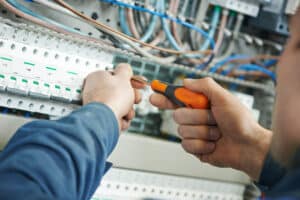
Walk into any modern manufacturing facility and you’ll notice something remarkable. Beyond the impressive machinery and bustling activity lies an intricate network of electrical systems powering every aspect of operations.
These aren’t just basic power connections – they’re sophisticated bespoke electrical solutions, like those from Tec-Stop, designed to maximise efficiency while maintaining the highest safety standards. From precision equipment requiring specialised wiring to automated packaging systems such as autobag configurations, today’s manufacturers depend on electrical infrastructure that’s both reliable and adaptable.
The critical role of modern electrical solutions in manufacturing
Manufacturing operations have evolved dramatically over the past decade. What once relied on simple electrical connections now demands comprehensive solutions that integrate seamlessly with digital systems, automation protocols, and safety networks.
Understanding manufacturing’s electrical demands
Modern manufacturing environments present unique electrical challenges. Equipment operates at different voltage levels, machinery requires precise timing controls, and safety systems must respond instantly to potential hazards. Custom electrical systems address these requirements by providing tailored solutions rather than one-size-fits-all approaches.
Consider a pharmaceutical manufacturing line. Standard electrical setups might suffice for basic operations, but specialised equipment demands precise voltage regulation, contamination-free wiring, and redundant safety systems. This complexity requires electrical solutions that account for both technical specifications and regulatory requirements.
Impact on operational performance
Industrial wiring solutions directly influence productivity. Well-designed infrastructure reduces downtime, minimises energy waste, and ensures consistent equipment performance. Many manufacturers report significant efficiency improvements when upgrading from legacy electrical systems to modern, optimised configurations.
Essential types of electrical solutions for manufacturing facilities
Different manufacturing processes require distinct electrical approaches. Understanding these variations helps facilities select appropriate solutions for their needs.
Bespoke electrical solutions for specialised operations
Manufacturing electrical safety begins with properly designed custom systems. These solutions consider environmental factors, equipment specifications, and operational requirements unique to each facility. Custom designs ensure compatibility between new installations and existing infrastructure while maintaining safety standards.
Industrial wiring solutions and infrastructure planning
Effective electrical automation starts with robust wiring infrastructure. Modern facilities require networks that support current operations as well as future expansion. This planning includes cable routing, conduit systems, and access points for maintenance activities.
Electrical control panels and automation integration
Power distribution centres on sophisticated control panels that manage multiple systems simultaneously. These panels integrate with manufacturing execution systems, quality control networks, and safety monitoring equipment to create unified operational environments.
Enhancing manufacturing efficiency through strategic electrical solutions
Efficiency gains come from strategic optimisation rather than piecemeal upgrades. Successful implementations focus on high-impact areas.
Power distribution solutions for optimal energy management
Energy costs represent a significant expense for manufacturers. Modern power distribution systems include monitoring that identifies consumption patterns, detects inefficiencies, and optimises load distribution across operations.
Smart electrical solutions automatically adjust power allocation based on production schedules – reducing waste during low-demand periods while ensuring adequate capacity during peak operations.
Electrical automation systems and smart manufacturing
Integration between electrical control panels and manufacturing systems enables advanced automation. These connections support predictive maintenance, real-time quality monitoring, and adaptive production scheduling based on performance data.
Electrical system optimisation techniques
Optimisation involves more than upgrading individual components. Comprehensive strategies assess entire electrical networks, identifying bottlenecks, redundancies, and improvement opportunities across interconnected systems.
Manufacturing electrical safety: Standards and best practices
Safety shapes every aspect of electrical system design and implementation.
Regulatory compliance and safety protocols
Manufacturing facilities must comply with multiple safety standards, including HSE guidance, BS EN regulations, and industry-specific requirements. Compliance strategies integrate safety features into system design rather than adding them as afterthoughts.
Risk assessment for factory electrical infrastructure
Regular assessments identify potential hazards before they escalate. These evaluations consider arc flash risks, ground fault protection, and emergency shutdown procedures as core safety components.
Emergency response and safety systems
Emergency systems activate automatically during crises, ensuring safe equipment shutdown and facility evacuation when necessary. These systems operate independently from main power networks to remain functional in emergencies.
Planning and implementation of industrial electrical components
Successful electrical projects require careful planning that considers both immediate needs and future requirements.
Assessment and design considerations
Initial assessments evaluate existing electrical infrastructure, identify improvement opportunities, and establish performance baselines. Design phases translate these findings into actionable implementation plans.
Installation best practices
Professional installation ensures electrical maintenance solutions remain effective throughout their operational lifespan. Proper installation techniques reduce failure rates, extend component life, and maintain system reliability.
Integration with existing systems
New electrical components must integrate smoothly with existing factory infrastructure. Integration planning prevents conflicts between systems while ensuring optimal performance across all electrical networks.
Electrical maintenance solutions for long-term reliability
Maintenance strategies significantly impact electrical system performance and operational continuity.
Preventive maintenance strategies
Scheduled maintenance activities prevent electrical failures before they occur. These strategies include regular inspections, component testing, and performance monitoring to identify potential issues early.
Predictive maintenance technologies
Advanced monitoring systems collect electrical performance data continuously, enabling predictive maintenance approaches that schedule repairs based on actual component condition rather than arbitrary time intervals.
Cost-effective maintenance planning
Effective maintenance balances system reliability with operational costs. Strategic planning prioritises critical systems while optimising maintenance schedules to minimise production disruptions.
What makes bespoke electrical solutions essential for modern manufacturing success?
Manufacturing competitiveness depends increasingly on electrical infrastructure that supports efficiency, safety, and adaptability. Facilities investing in comprehensive bespoke electrical solutions position themselves for sustained success in evolving industrial environments.
The path forward involves partnering with experienced electrical providers who understand manufacturing requirements and can deliver quality, bespoke solutions that grow with business needs. Now is the time to evaluate your electrical infrastructure and identify opportunities to improve operational efficiency and workplace safety.
Read more:
Electrical solutions in manufacturing: Improving efficiency and safety






